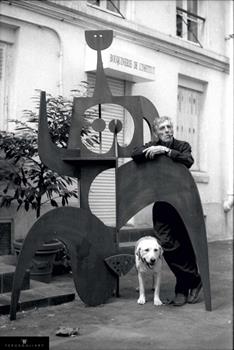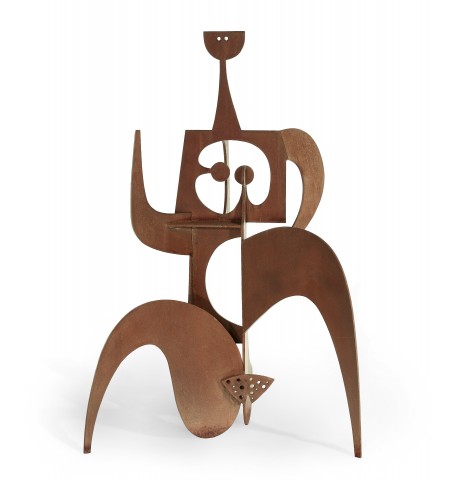LA MARATHONIENNE, 1981
PHILIPPE HIQUILY
cast 2004
steel with rust patina
190.0 x 127.0 x 74.0 cm height
signed and numbered at base: HIQUILY 5/8
Galerie des Lices, Saint-Tropez, France
Private collection, Melbourne, acquired from the above in August 2006
Hiquily, Fer, Galerie Ratton–Hourdé, Paris, September – October 2007 (another example)
Philippe Hiquily, Galerie LOFT, Paris, September – November 2008 (another example)
Philippe Hiquily et Wang Keping: Sculptures et Sensualité, Galerie LOFT, Paris, May 2009 (another example)
BRAFA, Tour et Taxis, Brussels, 21 – 30 January 2011 (another example)
Hiquily au Donjon de Vez, Vez, France, 4 July – 14 September 2014 (another example)
Hiquily, Galerie Laurent Strouk, Paris, 10 March – 9 April 2016 (another example)
Philippe Hiquily, Musée de la Vallée de la Creuse, Éguzon, France, 2 June – 22 September 2019 (another example)
Chen Yen–Fong, Hiquily, Erotisme, Mouvement et Humour en Sculptures, Artist no. 112, Taiwan–Taipei, September 1984, p. 170 (illus. another example)
Art dans la ville – 100 oeuvres, Vitry–Sur–Seine, France, 1988, p. 84 (illus., another example)
Joncquet, F., Hiquily, Éditions du Cercle d’Art, Paris, 1992, pl. 101, p. 126 (illus. another example)
Vinot, M., Jouffroy, A., Roudillon, J–F., Hiquily, T., Philippe Hiquily, Catalogue Raisonné: 1948–2011, Loft Editions, Paris, 2012, vol. I, cat. 358, pp. 265 (illus. another example), 269
La Marathonienne, 1981 – 82, corten steel, 500.0 cm height, public sculpture, Vitry–sur–Seine, France
HILQUILY.jpg

French post-war and contemporary artist Philippe Hiquily worked primarily in the field of sculpture over a career spanning 60 years. Almost immediately after his graduation from the École des Beaux Arts in Paris in 1959, his modern assemblages were collected by national museums in America (the Guggenheim and the Museum of Modern Art) and in France (Centre Pompidou) and later were installed in public urban areas and private homes around the globe.
Fiercely independent and with a singular aesthetic voice, Hiquily created surrealist figurative sculptures in tin and brass based on the female form, examples of which were keenly collected from his first exhibition in New York City, at The Contemporaries gallery, in 1959. Later, following in the footsteps of Spanish modernist Julio Gonzales and American kinetic sculpture pioneer Alexander Calder, Hiquily’s suite of geometric cut ironwork sculptures became monumental installations, the most well-known of which is La Marathonienne.
With a title referring to an ancient Greek female marathon-runner, La Marathonienne’s body is composed of disjointed geometric planes. Devoid of identifying features beyond her stylised breasts, she becomes an archetypal woman. The cut sheets of metal that comprise the limbs of Hiquily’s running woman span out from central axis. They are visible from every angle, and the windows pierced through the sheets create multiple simultaneous views of the figure metaphorically at the apex of her physical activity. Although La Marathonienne is undeniably static and monumental as opposed to being kinetically animated like Hiquily’s 1960s girouettes, the suggested rapid motion of her athletic pose is suspended in space and time.
Initially conceived in 1981 as a commission for public sculpture in the Parisian suburb of Vitry-Sur-Seine, the first example of La Marathonienne stands tall at 6m high of rusted steel. Fittingly, Hiquily’s icon of a modern sportswoman was installed in front of a sports centre, the Complexe Sportif Georges Gosnat. She was revisited much later by the artist, and in 2004, La Marathonienne was cast in editions of 8 in several sizes, some painted with black epoxy, and others, like this one, fabricated from steel, each recorded in the artist’s catalogue raisonné, published in 2010. In addition to appearing in prominent out-door sculptural installations in Paris, including in Place Saint-Germain-des-Près in 2012, La Marathonienne was beamed to a wider global audience through the American Showtime television series, Billions, where it was installed overlooking the bay of Villefranche-sur-Mer. She is a modern version of the monumental statue, a triumphant expression and celebration of the physical potential of the human body.
With a bold graphic geometric abstraction of the figure inspired by hieratic ancient Cycladic figurines, La Marathonienne’s proportions are exaggerated and reduced into a matrix of sweeping curves, sharp lines and delicately counter-balanced points. With Hiquily’s most profound geometric abstraction, La Marathonienne, and her angular, crouched counterpart, l’Épicurienne, while both figurative constructions, bear little resemblance to the artist’s former bulbous and insect-like female idols, Objets Mères. Instead, their folded and cut-out structures are reminiscent of paper snowflakes, cut and then unfurled around a central axis. The tension of open-work between La Marathonienne’s curves and straight edges animates the construction with a sense of lightness and movement that belies the sculpture’s material nature. Dr Malika Vinot, editor of Hiquily catalogue raisonné, describes this figure as ‘immortalised in an ultimate moment of grace, both strong and untameable, rendered vulnerable by the stolen moment in which she seems suspended.’1
1. Vinot, M., Jouffroy, A., Roudillon, J-F., Hiquily, T., Philippe Hiquily, Catalogue Raisonné: 1948-2011, Loft Editions, Paris, 2012, vol. I, p. 269
LUCIE REEVES-SMITH
